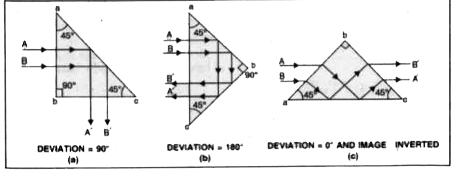Show by drawing ray diagrams how a totally reflecting glass prism can be used to deviate a ray of light through (i) 90∘ (ii) 180∘ and invert it.
Totally Reflecting Prisms. We know the critical angle of glass is about 41∘. If prism is so designed that its angles are 45∘,45∘,90∘, it is said to be a totally reflecting prism. Its principal section is a right-angled isosceles triangle. Since the rays are incident at angle of 45∘ i.e., greater than critical angle of glass (41∘ nearly), the rays suffer total internal reflection and the plane surfaces act as mirrors.

In figure (a), the reflecting face ac acts as a mirror which can produce a deviation of 90∘. If we use the prism as shown in figure (b), both faces ab and be act as mirrors. The emergent rays get inverted and also a deviation of 180∘ is introduced between incident rays and emergent rays. If prism is placed as in Fig. (c), the face ac acts as a mirror and inverts the image without producing any deviation. Such prisms are called erecting prisms.
Topper's Solved these Questions
- OPTICSBOOK - MBD -HARYANA BOARDCHAPTER - OPTICSEXERCISE - LONG ANSWER TYPE QUESTIONS
18 Videos
- OPTICSBOOK - MBD -HARYANA BOARDCHAPTER - OPTICSEXERCISE - OBJECTIVE TYPE QUESTIONS
26 Videos
- OPTICSBOOK - MBD -HARYANA BOARDCHAPTER - OPTICSEXERCISE - OBJECTIVE TYPE QUESTIONS
26 Videos
- MODEL TEST PAPER - 2BOOK - MBD -HARYANA BOARDCHAPTER - MODEL TEST PAPER - 2EXERCISE - SET - D ( LONG ANSWER TYPE QUESTIONS)
4 Videos
- PRINCIPLES OF COMMUNICATIONBOOK - MBD -HARYANA BOARDCHAPTER - PRINCIPLES OF COMMUNICATIONEXERCISE - Objective Type Questions
19 Videos
Similar Questions
(a) Obtain an expression for the effective focal length of a combination of two lenses placed in contact coaxially with each other.
(b) By drawing a diagram, show how can a totally reflecting prism to be used to deviate a ray of light through 180∘.
View SolutionShow by drawing a ray diagram, how a totally reflecting prism may be used to invert the image without changing its size and direction.
View Solution
Knowledge Check
In periscopes, totally reflecting prisms are used which turns the ray through
A180∘B90∘C270∘D45∘
Give the ray diagram showing reflection of light
View SolutionDraw a ray diagram to show a right angled isosceles prism may be used to ''bend the path of light rays by 90∘.
Write the necessary condition in terms of the refractive index of the material of this prism for the ray to bend to 90∘.
View SolutionDraw a ray diagram showing refraction of a light ray from a refracting glass slab.
View Solution(a) Deduce the expression, by drawing a suitable ray diagram, for the refractive index of a triangular glass prisms in terms of the angle of minimum deviation (D) and the angle of prism (A).
Draw a plot showing the variation of the angle of deviation with the angle of incidence.
(b) Calculate the value of the angle of incidence when a ray of light incident on one face of an equilateral glass prism produces the emergent ray, which just grazes along the adjacent face. Refractive index of prism is √2
View SolutionDraw diagrams to show polarised and unpolarised light are represented in a ray diagram.
View SolutionDraw ray diagrams to show how specially designed prism make use of total internal reflection to obtain inverted image of the object by deviating rays (i) through 90°, and (ii) through 180°.
View SolutionDraw a labelled ray diagram to show how a ray of light passes through a parallel sided glass block:
a) if it hits the glass block at 90∘ (that is perpendicular to the glass block).
View Solution
